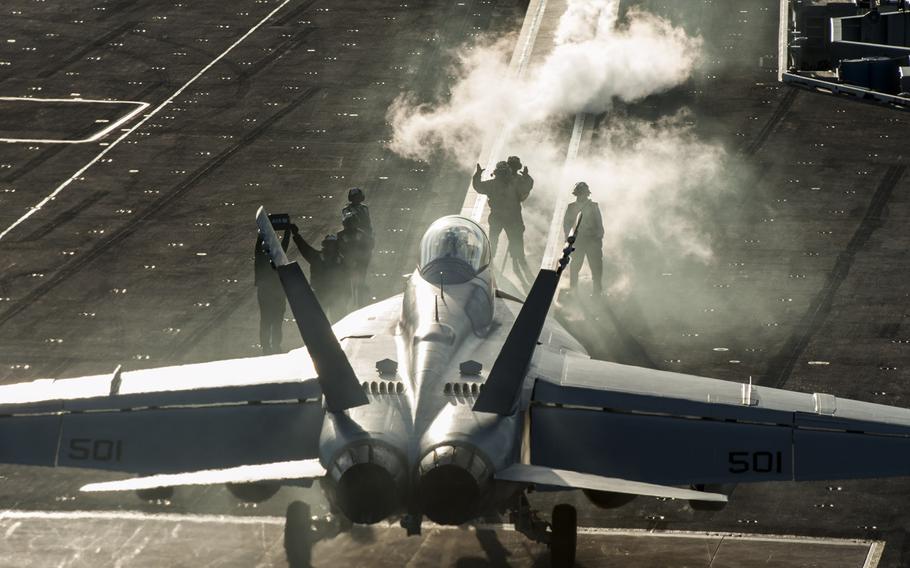
Sailors direct an EA-18G Growler, assigned to the ''Patriots'' of Electronic Attack Squadron 140, on the flight deck of aircraft carrier USS Harry S. Truman Nov. 16, 2015. The military uses the Growler to disrupt the enemy's communications. (L. A. Preston/U.S. Navy)
ABOARD THE USS HARRY S. TRUMAN — One of the most effective weapons in the Navy’s impressive arsenal isn’t designed to drop bombs or launch missiles. Instead, it keeps the enemy from being able to communicate.
The Boeing EA-18G Growler — the electronic warfare version of the F/A 18 Super Hornet multirole fighter — is designed to jam radio and cellphone communications that could be used to coordinate ambushes or other forms of attack. It also can disrupt electronics used to set off improvised explosive devices.
“Anything that can make a signal, that’s what we are there for,” said electronic warfare officer Lt. Chris Long, who is deployed with the “Patriots” of Electronic Attack Squadron 140. “If you talk on it, we go after it.”
The squadron is currently embarked aboard the aircraft carrier USS Harry S. Truman in the Persian Gulf.
The Growlers have been used primarily to ensure the freedom of movement for coalition partners in Iraq and Syria by disrupting the Islamic State group’s communications and, thus, affecting its ability to coordinate and conduct attacks.
“While we will not comment on specific operational employment of the EA/18G Growler in Iraq and Syria, I can say that the spectrum denial ability of the Growler is a critical part of the fight against [the Islamic State group] through tactical jamming and electronic protection capabilities,” said Lt. Ian McConnaughey, 5th Fleet Spokesman.
The Marine Corps recently sent a group of Northrop Grumman EA-6B Prowlers, the Growler’s predecessor, to Turkey to assist in electronic attack requirements for Operation Inherent Resolve.
The use of this type of aircraft against an asymmetrical threat like the Islamic State group showcases the evolving battlefield and the importance of electronic warfare, Long said.
“Anyone with any stars on their shoulders will tell you whoever controls the [electromagnetic] spectrum for the next war will win it,” he said. “Whether that’s radar, whether that’s keeping enemies from communicating and everything in-between, that’s where we live and that’s our job.”
The Growler is a relatively new piece of the Navy’s aircraft inventory: Its first deployment occurred in 2011.
Fighting the Islamic State group also is giving the Navy the chance to find new ways to use the Growler and to integrate it with other assets, said Lt. Drew Schnabel, a Growler pilot.
“We are looking forward to continue to develop the ways to use our aircraft,” said Schnabel. “We’ll pass on the lessons learned to the next squadron out here, and hopefully they can continue to further our aircraft’s ability to control the spectrum and use that against them (the Islamic State group).”
Earlier this year, the Navy awarded Raytheon a $1 billion contract for the “Next Generation Jammer,” which is expected to address increasingly complex threats within electronic warfare.
Twitter: @CChurchStripes